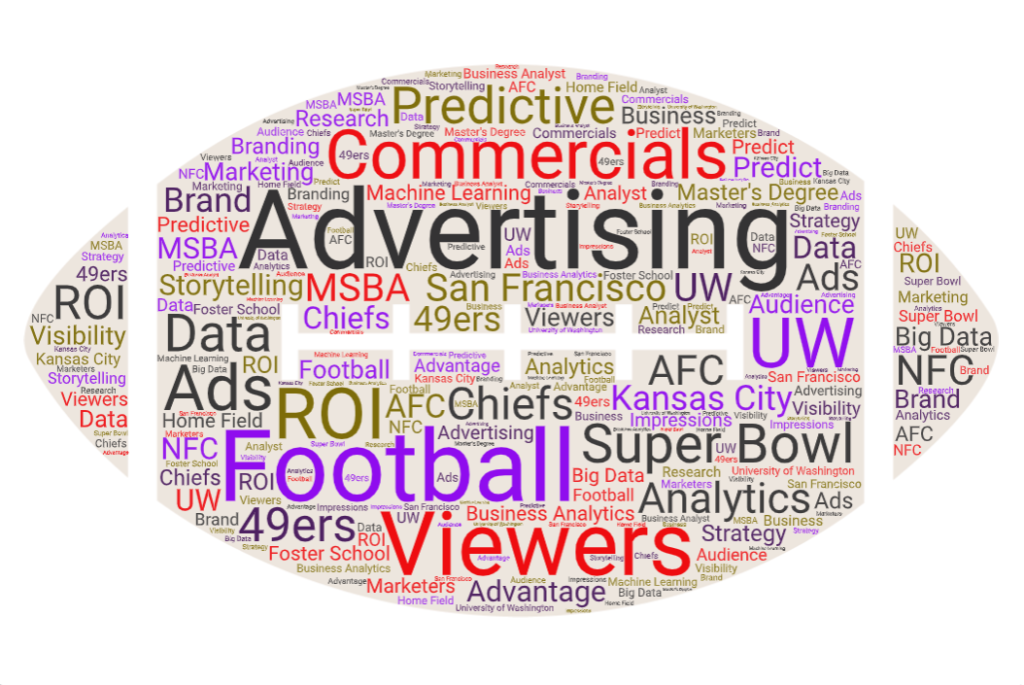The Future of Super Bowl Ads with Predictive Analytics
While some of the nation’s biggest brands are making headlines bynot airing Super Bowl ads this year, plenty of others are spending upwards of $5 million to reach what is projected to be the largest television audience of 2021. Foster MSBA Content Strategy Writer Olga Jimenez examines how Predictive Analytics is ensuring that is money well-spent.
 Super Bowl commercials have evolved tremendously since 1967, the inaugural year of the AFL-NFL World Championship Game, in which ads first aired. Back then, you could get away with calling Super Bowl viewership predictable, and marketers were the first to call it. Ads featured messaging clearly directed at one demographic– middle-aged white men. One such ad was that of Goodyear Tires, who ran a commercial urging men to allow their tires to be the surrogate prince for a damsel in flat tire distress.
Super Bowl commercials have evolved tremendously since 1967, the inaugural year of the AFL-NFL World Championship Game, in which ads first aired. Back then, you could get away with calling Super Bowl viewership predictable, and marketers were the first to call it. Ads featured messaging clearly directed at one demographic– middle-aged white men. One such ad was that of Goodyear Tires, who ran a commercial urging men to allow their tires to be the surrogate prince for a damsel in flat tire distress.
Raising the Stakes on ROI
Today, the stakes have gotten much higher, on many counts. For one, in the past decade, the Super Bowl has boasted some of the largest viewership counts in TV history, each game (with the exception of the 2019 New England Patriots v. Los Angeles Rams game), exceeding 100 million viewers according to Sports Media Watch. That is millions of viewers tuning in to watch the game, halftime show, and the ads in between. This year alone, 102 million viewers tuned in to watch the Kansas City Chiefs and the San Francisco 49ers. Viewership since 1967 has doubled and diversified, and ad costs for that same 30-second commercial have skyrocketed from $37,500 to about $5 million according to Nielsen Media Research.
With stakes this high, marketers have had no choice, but to prepare as much as possible, or risk losing money. An industry that once could easily rely on a good punchline or celebrity ambassador, now uses as many analytics as an NFL team to come out of the Super Bowl winning. Today’s marketing teams combine storytelling with big data, machine learning, AI and analytics to identify messaging opportunities that are culturally relevant, increase brand visibility, and generate huge revenue. A tool like predictive analytics is akin to game tapes for football players. Marketing research analysts examine data on a product’s past performance to predict how it will do in the future, just like football teams use game tapes to analyze how their opponents will behave in future games.
Predictive Analytics Gives a Home Field Advantage
The more data a company has about their audience, the better models they can create to predict how a consumer will react to a product, service, or particular message. According to instapage, once the mining and predictive analytics have been conducted, marketers have the ability to “develop more effective marketing and advertising strategies. Not just by targeting the right audience, but by targeting them with messages, images, and themes that will attract them to your product or service.” Using predictive analytics, marketers increase the likelihood of their ads resonating with consumers. That’s a huge home field advantage for marketing teams spending millions of dollars on 30 seconds of airtime. Undoubtedly, it is a mix of analytics and storytelling which led to decisions like Microsoft highlighting first woman coach, Katie Sowers, in their “Be the One” campaign at a time when female empowerment has steadily been on the rise. A choice that landed Microsoft’s ad in the top 10 (no.8) Super Bowl ads of the year for it’s inspiring message and cultural relevance.
The Future of Super Bowl Ads
As markets grow and compete for attention from consumers, marketing teams will have to rely more and more on the competitive edge that big data, AI, and predictive analytics give them. It’s the most logical step to take for companies taking millions of dollars and betting them on 30 of the 31,536,000 seconds we have in a year.
Interested in a future using storytelling and data to make compelling cases for business strategies using tools like predictive analytics, data mining, and machine learning? Learn more about our Master of Science in Business Analytics one year program at the UW Foster School of Business.
Written by Olga Jimenez
MSBA Content Strategy Writer
[email protected]
